Tábor Streets, 12 postcards
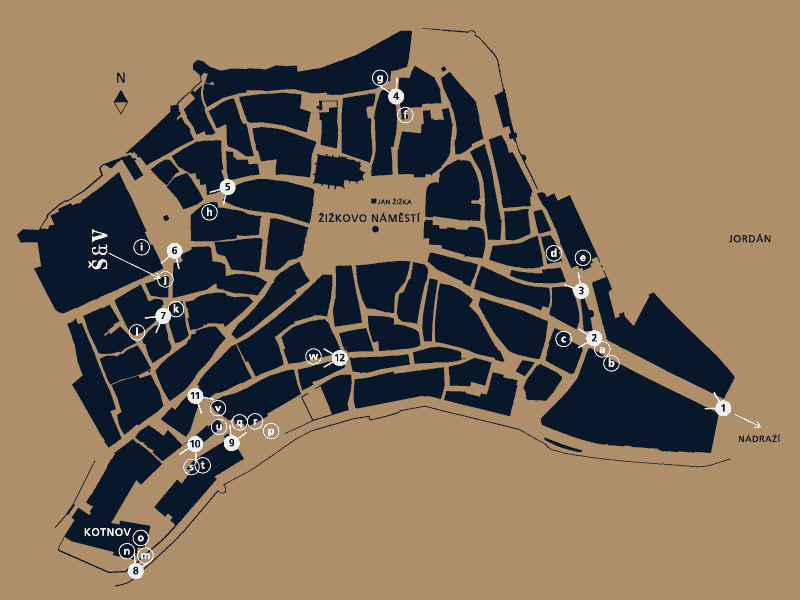 |
1 Palackého, 1882
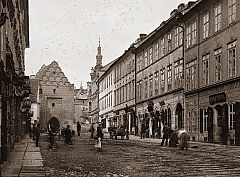 Originally known as
Novobranská (New Gate) Street, this street was later renamed
Palackého Street, after famous Czech historian František Palacký.
The street was built in 1861, following the demolition of two of
the old city gates, which had been part of the town fortifications.
This is one of very few photographs of the third and last gate,
Prague Gate (a), which was demolished in
1884. Today, this is the site of the entrance to the Oscar Nedbal
Theatre (b).
Originally known as
Novobranská (New Gate) Street, this street was later renamed
Palackého Street, after famous Czech historian František Palacký.
The street was built in 1861, following the demolition of two of
the old city gates, which had been part of the town fortifications.
This is one of very few photographs of the third and last gate,
Prague Gate (a), which was demolished in
1884. Today, this is the site of the entrance to the Oscar Nedbal
Theatre (b).2 Pražská, 1900
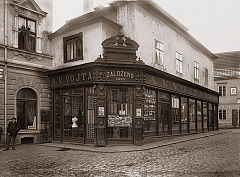 Pražská (Prague)
Street, from Žižka Square to the former Prague Gate, used to be the
start of the only road from Tábor to Prague, and was lined with
shops and small craft workshops. It featured historic houses, with
fronts decorated by small arches and “envelope” façades, typical
Tábor architecture of that time. In 1900, corner house #211
(c) was a general store owned by
Anotonín V. Vojta. After WWII, it was for a long time a glass
and porcelain shop. Today, it is an Ober-bank.
Pražská (Prague)
Street, from Žižka Square to the former Prague Gate, used to be the
start of the only road from Tábor to Prague, and was lined with
shops and small craft workshops. It featured historic houses, with
fronts decorated by small arches and “envelope” façades, typical
Tábor architecture of that time. In 1900, corner house #211
(c) was a general store owned by
Anotonín V. Vojta. After WWII, it was for a long time a glass
and porcelain shop. Today, it is an Ober-bank.3 Žižkova, 1915
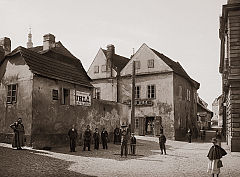 From Palackého
Street up to Tržní (Market) Square is Žižkova Street, named after
the famous warrior-commander, and co-founder of Tábor, Jan Žižka
from Trocnov. The corner house #247 (d)
opposite the dance-hall “Střelnice House“ (e) belongs to Prokopova Street, named after another
famous Hussite warrior, Prokop the Great. In 1915, house #247 was
owned by Marie Kulveitová, and the shop was run by Raimund Dvořák.
Today, it is an antique shop.
From Palackého
Street up to Tržní (Market) Square is Žižkova Street, named after
the famous warrior-commander, and co-founder of Tábor, Jan Žižka
from Trocnov. The corner house #247 (d)
opposite the dance-hall “Střelnice House“ (e) belongs to Prokopova Street, named after another
famous Hussite warrior, Prokop the Great. In 1915, house #247 was
owned by Marie Kulveitová, and the shop was run by Raimund Dvořák.
Today, it is an antique shop.4 Dlouhá, 1915
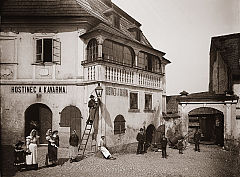 From Tržní (Market)
Square, we go up to Špitálská (Hospital) Street, named after the
medieval hospital that stood next to the small hospital chapel
(f), which is now the Orthodox church.
House #344 (g) belonged to Václav
Poněšický, the first Tábor water engineer, responsible for the
maintenance of the fountains and water tower in the city. At the
time of taking this photograph, it was a pub and coffee-shop, “U
třech kopů”, (Three heaps), and was owned by Marie Schönová, widow
of the former Mayor of Tábor. The pub, “U Šetků”, stood here till
the 1960s.
From Tržní (Market)
Square, we go up to Špitálská (Hospital) Street, named after the
medieval hospital that stood next to the small hospital chapel
(f), which is now the Orthodox church.
House #344 (g) belonged to Václav
Poněšický, the first Tábor water engineer, responsible for the
maintenance of the fountains and water tower in the city. At the
time of taking this photograph, it was a pub and coffee-shop, “U
třech kopů”, (Three heaps), and was owned by Marie Schönová, widow
of the former Mayor of Tábor. The pub, “U Šetků”, stood here till
the 1960s.5 Křížkova, 1929
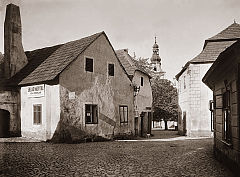 From Svatošova
Street we can see house #35 (h) in
Křížkova Street, formerly Jungmannova Street. Svatošova Street was
named after Tábor schoolteacher, Josef Svatoš. In 1826 he designed
a village he called Old Tábor. It later carried his name, Svatošov,
but is now known as Sezimovo Ústí. Křížkova Street is named after
the first principal of Tábor High School, Václav Křížek. House #35
was originally a store for the cabinetry workshop STOLAR, founded
in 1926. František Lemberka opened his tobacconist shop in 1929, in
the same house. In the background we can see the Cloister Church of
Birth of Virgin Mary (i), dating from
1666.
From Svatošova
Street we can see house #35 (h) in
Křížkova Street, formerly Jungmannova Street. Svatošova Street was
named after Tábor schoolteacher, Josef Svatoš. In 1826 he designed
a village he called Old Tábor. It later carried his name, Svatošov,
but is now known as Sezimovo Ústí. Křížkova Street is named after
the first principal of Tábor High School, Václav Křížek. House #35
was originally a store for the cabinetry workshop STOLAR, founded
in 1926. František Lemberka opened his tobacconist shop in 1929, in
the same house. In the background we can see the Cloister Church of
Birth of Virgin Mary (i), dating from
1666.6 Filipovská, 1906
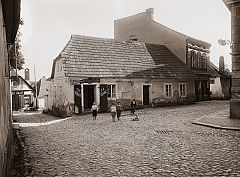 On the south side
of Mikuláše z Husi (Nicholas of Hus) Square, on the corner of
Filipovská and Soukenická Streets, we can see old house #72
(j). It was called “U Lípy” (By the lime
tree), after the lime tree that once stood in the cloister garden
where the school now stands. Builder Jan Pravda bought the house in
1904, demolished it in 1908, and built a new two-storey house with
a restaurant and a pension (private hotel). Today, “U Lípy” is a
café and confectionery store, and is the home of the Šechtl &
Voseček Museum of Photography.
On the south side
of Mikuláše z Husi (Nicholas of Hus) Square, on the corner of
Filipovská and Soukenická Streets, we can see old house #72
(j). It was called “U Lípy” (By the lime
tree), after the lime tree that once stood in the cloister garden
where the school now stands. Builder Jan Pravda bought the house in
1904, demolished it in 1908, and built a new two-storey house with
a restaurant and a pension (private hotel). Today, “U Lípy” is a
café and confectionery store, and is the home of the Šechtl &
Voseček Museum of Photography.7 Křížová, 1910
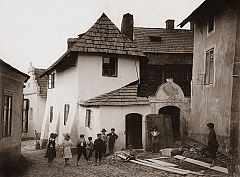 Soukenická (Draper)
Street was named after the drapery workshops, from the time, in the
19th century, when drapery was one of the dominant crafts in Tábor.
In 1910, house #91 (l) was owned by Jan
Effermet, a baker from Sedlec. The entrance to house #91 was in
Křížová (Cross) Street, the street which gave access across the
Town Park, and to the Way of the Cross approaching Klokoty
Monastery. Despite façade changes, the main features have been
preserved, and today, it is one of the most beautiful houses in
Tábor.
Soukenická (Draper)
Street was named after the drapery workshops, from the time, in the
19th century, when drapery was one of the dominant crafts in Tábor.
In 1910, house #91 (l) was owned by Jan
Effermet, a baker from Sedlec. The entrance to house #91 was in
Křížová (Cross) Street, the street which gave access across the
Town Park, and to the Way of the Cross approaching Klokoty
Monastery. Despite façade changes, the main features have been
preserved, and today, it is one of the most beautiful houses in
Tábor.8 Na Parkánech, 1900
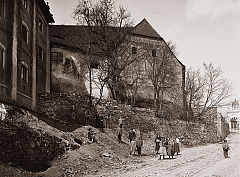 View to Na
Parkánech (Battlements) Street, at the time of reconstruction of
the second battlement wall (m) of Kotnov
Castle. On the left is the main building of the brewery
(n), and then the malt house
(o), built into one of the four towers
of the original Hradiště Castle. Behind the brewery cellars and
stores, rebuilt in the 1920s, is the front of the Jewish Synagogue
(p), built in 1885. Today, the old malt
house contains the exhibition, “Tábor Treasure”.
View to Na
Parkánech (Battlements) Street, at the time of reconstruction of
the second battlement wall (m) of Kotnov
Castle. On the left is the main building of the brewery
(n), and then the malt house
(o), built into one of the four towers
of the original Hradiště Castle. Behind the brewery cellars and
stores, rebuilt in the 1920s, is the front of the Jewish Synagogue
(p), built in 1885. Today, the old malt
house contains the exhibition, “Tábor Treasure”.9 Hradební, 1890
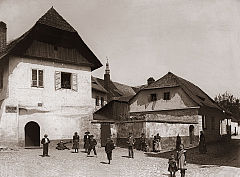 Hradební (Town
Wall) Street is at the site of the original Tábor city wall. We are
looking from the battlements to house #181 (q), called Šiškovský, an example of the beauty of
the houses and alleys of Tábor Old Town. It was rebuilt in this
style by bricklayer Krištof Švarz, around 1700. At the time the
photograph was taken, the house was owned by Marie Bílá. The house
on the right, #182 (r), was owned from
1882 by the Jewish Religious Society.
Hradební (Town
Wall) Street is at the site of the original Tábor city wall. We are
looking from the battlements to house #181 (q), called Šiškovský, an example of the beauty of
the houses and alleys of Tábor Old Town. It was rebuilt in this
style by bricklayer Krištof Švarz, around 1700. At the time the
photograph was taken, the house was owned by Marie Bílá. The house
on the right, #182 (r), was owned from
1882 by the Jewish Religious Society.10 Kotnovská, 1890
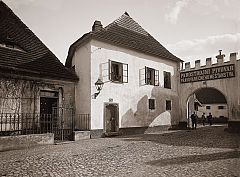 The start of Kotnov
Street is next to the entrance to the former brewery, which had
been built near Kotnov Castle in 1612. House #129 (s) was originally the town jail. It was bought and
demolished by the brewery, at the end of the 19th century. Next to
it, house #132 (t), a former barn,
together with the gate, is also gone. Today, this is the site of
the Dvořák Hotel.
The start of Kotnov
Street is next to the entrance to the former brewery, which had
been built near Kotnov Castle in 1612. House #129 (s) was originally the town jail. It was bought and
demolished by the brewery, at the end of the 19th century. Next to
it, house #132 (t), a former barn,
together with the gate, is also gone. Today, this is the site of
the Dvořák Hotel.11 Kotnovská, 1890
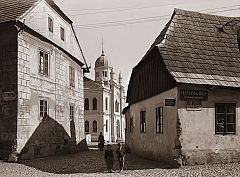 In Kotnov Street,
house #132 (u) on the right, at the time
this photograph was taken, was owned by a metal-worker and repairer
of umbrellas. House #180 (v) on the left
dates from the mid-17th century, and was known as Kaplíř’s House.
In the 18th and 19th centuries, it was occupied by drapers and
tailors. Between these houses we see the façade of the
Moorish-style Tábor synagogue (p). The
senseless destruction of this important building in 1977 was a sad
loss to Tábor. Today the site is used as a car-park, with only a
memorial plaque to mark its former importance.
In Kotnov Street,
house #132 (u) on the right, at the time
this photograph was taken, was owned by a metal-worker and repairer
of umbrellas. House #180 (v) on the left
dates from the mid-17th century, and was known as Kaplíř’s House.
In the 18th and 19th centuries, it was occupied by drapers and
tailors. Between these houses we see the façade of the
Moorish-style Tábor synagogue (p). The
senseless destruction of this important building in 1977 was a sad
loss to Tábor. Today the site is used as a car-park, with only a
memorial plaque to mark its former importance.12 Kotnovská, 1908
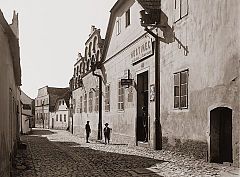 Kotnov Street runs
from Kotnov Castle up to Školní (School) Square, lined with houses
from the 16th and 17th centuries. Those we see on this photograph
are typical, with round arches, renaissance frontages and baroque
modifications. The façade of house #138 (w) was renovated in the Empire style. At the
beginning of 17th century, the house became a lively pub. At the
time the photograph was taken, it was called “U zlaté koruny”
(“Golden Crown”), and was owned by Antonie Havrdová. Today it
houses the Kodet Museum.
Kotnov Street runs
from Kotnov Castle up to Školní (School) Square, lined with houses
from the 16th and 17th centuries. Those we see on this photograph
are typical, with round arches, renaissance frontages and baroque
modifications. The façade of house #138 (w) was renovated in the Empire style. At the
beginning of 17th century, the house became a lively pub. At the
time the photograph was taken, it was called “U zlaté koruny”
(“Golden Crown”), and was owned by Antonie Havrdová. Today it
houses the Kodet Museum.— Jiří Kohout
Authors of photographs: Ignác and Josef Jindřich Šechtl / texts and dating of photographs: Jiří Kohout / typography: Jakub Troják / translation: Eleanor Schlee and John Titchener / map: Eva Hubičková and Jakub Troják / preparing photographs for print: Jan Hubička / published by: Marie Šechtlová (e-mail: marie@sechtl-vosecek.ucw.cz) / printed by: Protisk České Budějovice, 2006